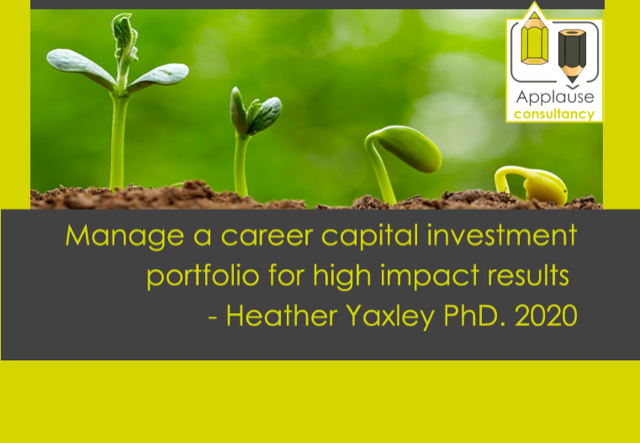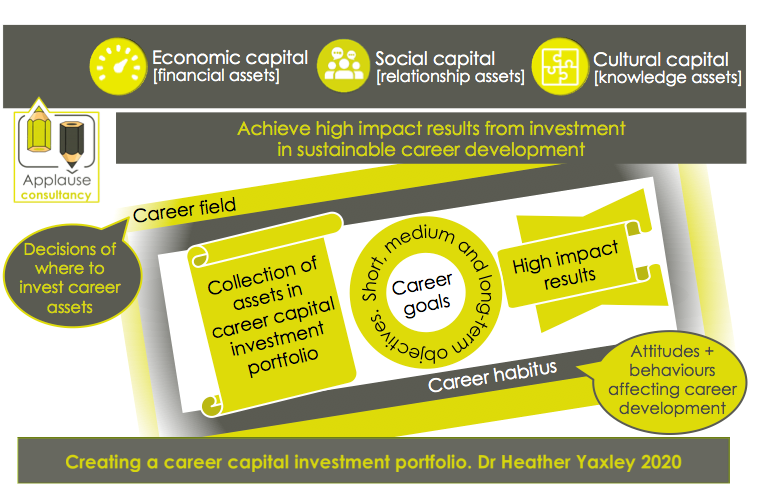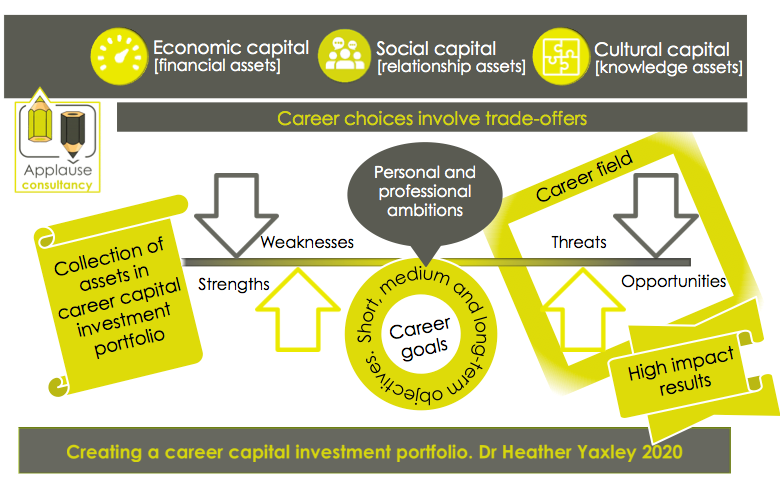Investing in career capital for high impact results

About the author
Heather is a key member of our assessor team. PhD, BSc, PG, RSA, CAM

What are the best options to achieve high impact results in developing your career? In this article, Dr Heather Yaxley explains how to create a career capital investment portfolio, drawing on Bourdieu’s theory of practice.
An investment portfolio is a collection of assets. Applying this concept to careers helps you achieve high impact results in the quality or value of your career from investment in sustainable professional development.
Capital is considered normally in relation to financial assets. In this case, high impact results involve taking career decisions to deliver the greatest economic return. Financial capital – and lack of it – also influences the choices you are able to make.
However, the French intellectual, Pierre Bourdieu, proposed other types of capital, notably cultural and social, in his theory of practice. These offer a wider range of assets, goals and high impact results to include in your career capital investment portfolio. For example, in relation to maximising the value of what you can do well (skills) as a knowledge asset which is indicated in the description of career capital as:
“The skills you have that are both rare and valuable and that can be used as leverage in defining your career.” Cal Newport, computer science professor and author.
In addition to capital, Bourdieu’s theory of practice includes field and habitus. Broadly these relate to where to invest your career assets, as well the attitudes and behaviours that affect development of your career.
 To create a career capital investment portfolio the first step is to identify and develop the collection of assets required to achieve your short, medium and long-term objectives. Next you will need to decide where to invest these assets, and determine your attitude towards career development behaviours. You should also take into account how other people’s attitudes can affect the investment of your career assets and the results you can achieve.
To create a career capital investment portfolio the first step is to identify and develop the collection of assets required to achieve your short, medium and long-term objectives. Next you will need to decide where to invest these assets, and determine your attitude towards career development behaviours. You should also take into account how other people’s attitudes can affect the investment of your career assets and the results you can achieve.
Career choices involve trade-offs in balancing the strengths and weaknesses in your portfolio of assets, alongside your personal and professional ambitions, and any opportunities and threats that may be anticipated when developing sustainable career capital in particular industries, organisations, occupations or roles.
 For instance, knowledge of artificial intelligence (AI) could be a strong asset in your career portfolio. If this fits with your goals, determine a time-related development objective. Consider opportunities and threats affecting the risk of investing in AI competency in your career field. Currently it offers a competitive advantage (opportunity), but if this asset becomes commonplace (threat), its career capital value could be reduced. This helps you evaluate the worth of this asset in your career capital portfolio.
For instance, knowledge of artificial intelligence (AI) could be a strong asset in your career portfolio. If this fits with your goals, determine a time-related development objective. Consider opportunities and threats affecting the risk of investing in AI competency in your career field. Currently it offers a competitive advantage (opportunity), but if this asset becomes commonplace (threat), its career capital value could be reduced. This helps you evaluate the worth of this asset in your career capital portfolio.
Achieving high impact career results may require taking a risk on pro-active professional development of an asset that offers the potential for sustainable return on investment of time, money and other resources.
If you are risk averse, you may prefer to adopt a passive method for your career capital investment portfolio. Rather than using personal agency, you will rely on others (proxy agency) to influence your career development. High impact results are possible from this investment index strategy. Traditionally this meant alignment of your personal career capital to a field (occupation, organisation, or industry) that offered stability of employment and the potential for hierarchical career progression.
Although career security is less common today, this approach has merit in organisations that invest in staff development, offer opportunities for advancement or otherwise boost your career capital. An example that helps to deliver high impact results is where employers encourage and fund study of professional qualifications, such as those offered by PR Academy.
Another passive method that I found to be common in my PhD research is to depend on chance as a career strategy. Being opportunistic means taking advantage of career opportunities when they come your way. You may be fortunate in the choices you are able make. Alternatively you could end up with a weak collection of assets in your career capital investment portfolio and fail to achieve your ambitions or gain high impact results.
Within organisations, the knowledge, skills and abilities of employees constitute human capital, an intangible asset that offers a competitive advantage. This can be seen in the definition of career capital as:
‘Non-financial assets embodied in the skills, expertise, and relationship networks that employees acquire as their careers unfold.’ Inkson & Arthur, career studies academics
Relating to Bourdieu’s theory of practice:
- Skills and expertise (knowledge assets) contribute towards cultural capital;
- Professional and personal networks (relationship assets) contribute towards social capital.
Organisations manage, measure and report on the strategic value of human capital on an active basis. This ‘talent management’ approach also applies to functions, including public relations, internal communication, public affairs and corporate communication. Hence enhancing individual and team assets will boost the human capital of a function and the organisation.
As well as investment in training and development activities, cultural capital is gained through experience, problem solving and adopting the habits of reflective thinking. You need to consider how to develop relevant capabilities to maximise your potential.
Read my Dr Yaxley article: How to use a capability framework to upscale your career to discover more about using the three stages of career reflective thinking to look at accomplishments, activities and ambitions, and improving the quality and value of careers for individuals and teams
You should learn what is valued as cultural capital in your chosen career fields. This will encompass knowing about a range of things, including professional and personal presentation. In public affairs, knowledge and experience concerning processes and practices relating to policy formation and political decision-making have value as cultural capital.
Social capital is gained through building connections, managing relationships, and participating in professional networks. It also includes aspects of emotional intelligence such as empathy and sympathy. Social capital offers career benefits to individuals but also is of value to teams, organisations and within a professional field. Collective agency through collaborating and sharing knowledge with others helps to create social capital. Being trusted and having a good reputation are important relationship assets in your career capital investment portfolio.
Another way that organisations increase human capital is by recruiting individuals who have acquired knowledge and relationship assets and offer a high level of career capital. This means that when you are looking for a new position, understanding the value of the knowledge and relationship assets in your career capital investment portfolio will help you communicate clearly the benefits these will bring to the employer.
The same thinking applies for independent practitioners or consultancies in securing new work. Indeed, a pro-active approach to increasing your career capital is essential if you are self-employed or run your own business. It is also advisable when you are likely to experience frequent mobility between roles or employers. A portable record of your continual professional development (such as that offered by CIPR) will be useful in analysing and assessing your career capital assets.
Clearly, it is important for individuals, as well as those who manage human capital within organisations and functions, to audit and evaluate the collection of assets within a career capital investment portfolio. Doing so will help identify advantages as well as areas where there is a lack of economic, social and cultural capital.
Application of critical thinking is necessary to ensure this approach takes account of individual and collective diversity and inclusivity. There has been a tendency in career fields – including public relations and allied occupations – to favour certain social and cultural assets. Even accessing some fields requires levels of economic, social and cultural capital that limits career opportunities and leads to occupational closure. This has been noted as an issue in gaining experience in public relations.
Likewise, attitudes (our own and others) may restrict our ambitions and reduce our ability to develop effectively our career capital investment portfolio. There are points in careers where priorities and ambitions alter. Not only is this a trigger for review of your portfolio, but may suggest a change in strategy. In career studies, maintaining relationship assets often replaces investment in knowledge assets. However, lifelong learning encourages continual development of professional capabilities to offset possible decline in value of career capital.
An analysis of the collection of assets within an organisation should take account of these factors to invest in individuals and teams on an equitable basis. Flatter organisational structures and other work related changes put the value of your career capital portfolio at risk of plateauing without active investment. Again this highlights the need for self-management of your collection of assets throughout your career. This is particularly true should you be unsuccessful in seeking a career move. Those who secure new positions benefit from a boost of investment in their cultural and social capital, putting them at an increasing advantage of other candidates.
To create your career capital investment portfolio, review your current collection and identify the mix of assets that will help you achieve your personal and professional ambitions. Identify where you may wish to address areas of weakness or reinforce your strengths in relation to your chosen field of work. Monitor career opportunities and threats in this area and develop a plan to manage investment in your portfolio.
Remember to challenge your own attitudes and behaviours as well as those of others in ensuring unfair limitations are not placed on your capability to achieve high impact results to improve the quality or value of your career.